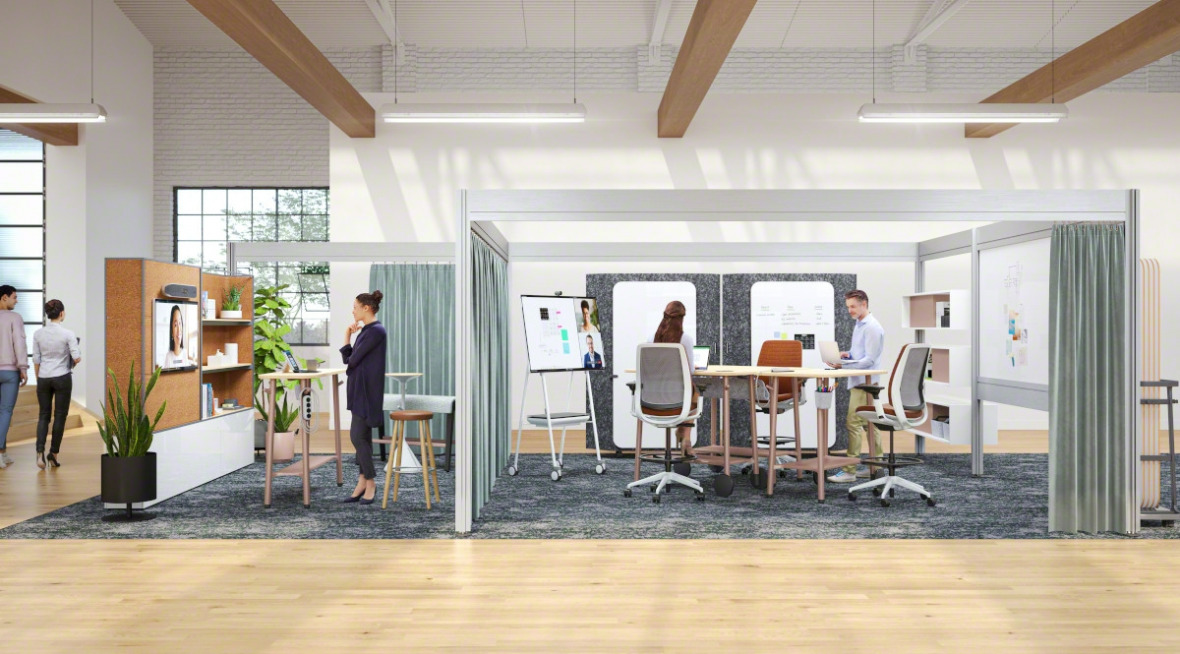We use cookies to make this site as useful as possible and maximize your experience. By closing this message, you consent to our cookies on this device in accordance with our cookie policy unless you have disabled them in your browser settings.
Guide to In-House and Remote Hybrid Work Environments

Create a High-Performing Hybrid Work Environment Using Three Concepts
The future of workspaces is here – maximize your hybrid potential.
In the last few months, corporations were given the green light to safely welcome employees back into the office. However, there has been a considerable rise in interest in utilizing a hybrid work environment concept, a structure that allows employees to work both remotely and in the office. As leaders pivot to this new demand, they are questioning the elements of successful onboarding to a hybrid environment that enforces productivity, employee collaboration, and their overall company culture.
Investing in the right technology makes hybrid work attainable, but what about the fundamentals? It is important to know how to implement the technology to create sustainability for the long term. After thorough research, three key concepts have been identified for attaining a high-performing hybrid work environment: equity, engagement, and ease. Each one provides the groundwork to support connection, whether that be through individual meetings or company-wide gatherings.
Equity to Create a True Collaboration Environment
All spaces are now video spaces, so it’s important to have employees feel comfortable in front of the lens when they are remote and in-office. There are two factors that determine this: visual and audio.
Visual: A LED light above head height is best for video, it creates a warm ambiance that increases an employee’s confidence. In addition, encourage all participants to move around the room to minimize the feeling of being “on stage”, this can be done through mobile furniture.
Audio: The core aspect of meetings is to communicate, making high-quality audio a necessity. Before joining online, check the microphone to ensure all participants can clearly hear you.
Sparking Engagement for Employee Collaboration
Collaborative work environments are no longer dependent on being in-person, as technology has enabled corporations to create the same experience virtually. To begin, separate groups to their designated niche and location (i.e. digital content vs. analog content, remote vs. local participants) to increase overall engagement. For remote meetings, there is a series of steps you can take to increase participant engagement, such as:
- Check the Camera: Minutes prior to a meeting, check the camera’s field of view to see if the audience can clearly view you and any content you would like to share. A wide-angle lens offers the opportunity to share more of the background, making it a great addition for multiple people sharing one interface.
- Have Multiple Interfaces: This allows the user to view the participants and the content displayed simultaneously.
- Content Creation Tools: Utilize shared content creation tools to increase modes of collaboration.
Ease to Create a Seamless Transition
Employees will be navigating between in-office and virtual realities, so it’s important to make the transition seamless by offering intuitive and easy navigation. In the physical workspace, keep an aesthetic that is simple. Offer mobile devices and flexible furniture to allow in-office employees to maneuver throughout the office and to pivot needs of remote participants during a virtual meeting. In addition, offering technology that is easy to connect to (through personal and shared devices) helps an employee feel at ease.
Etiquette and Protocols
Previously in the office, values and norms could be swept under the rug. In an environment as physically dispersed as a hybrid work environment, firmly establishing workplace etiquette and protocols is crucial for not only maintaining but increasing, equity, engagement, and inclusion.
- Schedule Transparency: Create open communication for employees that will be in-office and those that will be remote. This increases employee collaboration, and it gives them the opportunity to connect in person or to anticipate the technology that will be needed for remote work.
- Social Start: Open the meeting with a social strategy to make everyone feel more comfortable by introducing themselves. Let the small talk simmer for a few minutes, then dive into the meeting’s purpose.
- See and Be Seen: To make sure visibility is at an all-time high, consider requesting an in-office employee to pay attention to what is being seen remotely. Ask whether or not the camera is centered, if the content can be seen, and if the audio is clear.
- Hear and Be Heard: Place an emphasis on being in team meetings to share ideas, road maps, strategies, and general feedback. These discussions require high-quality audio to ensure all participants are heard.
- Pause with Purpose: Let your employee’s voices be acknowledged. Ask questions and create an open discussion to engage them with the topic.
- Clear Next Steps: End the meeting with an overview of what was discussed and the anticipated next steps.
Are you interested in learning more? Click here to watch a Make Hybrid Work webinar. For more information on what a high-functioning hybrid work environment looks like for you, complete this contact form to receive a FREE risk assessment and floor plan analysis.
